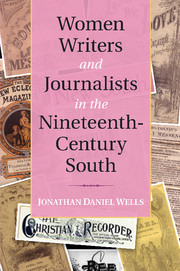Epilogue - Women???s Press Associations and Professional Journalism
Published online by Cambridge University Press: 25 October 2011
Summary
Toward the end of her life in 1896, Eliza Nicholson lamented that she did not enjoy the fellowship experienced by her male peers. “As the proprietor of a newspaper,” she admitted to a Boston audience, “my position is, in a way, lonesome and peculiar…. I miss the pleasure and encouragement men of our profession have in friendly association.” Male editors in North Carolina formed their own press association in 1873. However, until the late 1870s and 1880s no such organizations for women in the South existed. Given the personal and professional relationships formed among female members of the press, it is not surprising that in an age in which women across the country formed all kinds of organizations they should band together to form women’s press clubs and associations. Perhaps even more importantly for the women’s rights cause, female journalists and editors wished to be considered professionals, and forming press associations was a useful way to increase their professional status. The numbers of female journalists nationwide had risen from 288 in 1880 to 1,888 in 1890 and more than 2,000 in 1900 according to the federal census data, and the formation of press clubs was one avenue for prominent female members of the press to maintain standards and promote the status of their profession.
The formation of press associations for southern women was part of a national movement to establish such clubs. Among the first was the New England Press Association, formed in 1885 by Marion McBride and several other Boston newspaperwomen. In the 1880s and 1890s, women’s press associations were formed in Utah, Ohio, Illinois, New York, California, Michigan, and Colorado; and the Women’s Press Association counted 700 members by 1900. Thus, the associations formed in the South in the last two decades of the nineteenth century, particularly in Georgia, Texas, and Mississippi, were very much in line with their northern and western cousins.
- Type
- Chapter
- Information
- Women Writers and Journalists in the Nineteenth-Century South , pp. 201 - 212Publisher: Cambridge University PressPrint publication year: 2011



